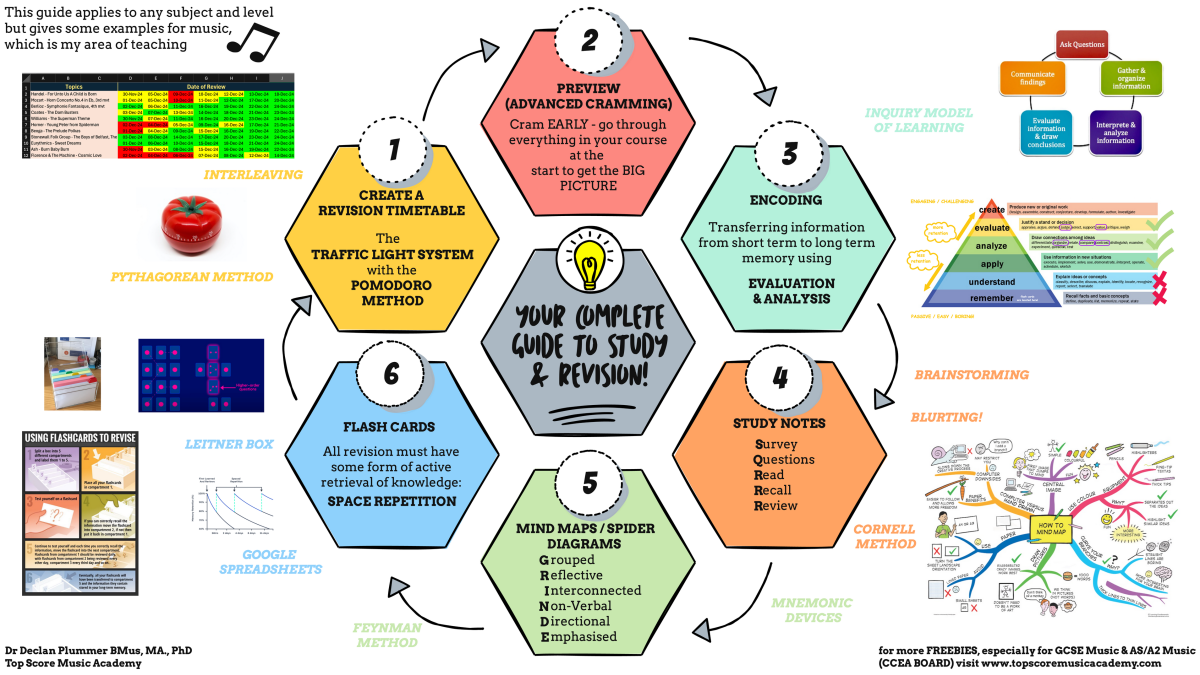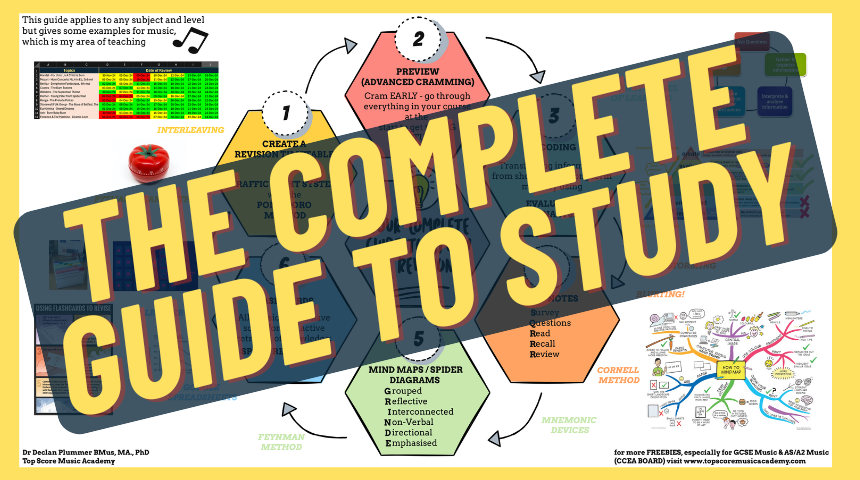The Complete Guide to Study: A 3-Stage Framework for Music Students

Smart study guide for music students: planning, note-taking, mind maps, and proven memory techniques for effective music revision.
A 3-Stage Revision Process
Based on TSMA’s “How to Study” series by Declan Plummer.
1. Preparation & Organising
Key insights (from “Part 1 – Preparation & Organising”) topscoremusicacademy.com
- Before diving into notes or analysis, you need a system: something flexible, structured, personalised. Without it you “focus on what feels easy rather than what needs improvement.” topscoremusicacademy.com+1
- The GROW method for a revision timetable: Grid (topics × dates), Rating (traffic-light colour-code), Overall goal (turn the grid greener), Weakest topic first. topscoremusicacademy.com
- Grid = list your set works/topics down the side, dates across the top. Colour-code red/yellow/green.
- Weakest topics get priority.
- Use smart cognitive strategies:
- Interleaving: mix different topics/styles rather than doing one forever. topscoremusicacademy.com
- Pythagorean Reflection-Method: review before sleep — mentally replay the session to strengthen memory consolidation. topscoremusicacademy.com
- Pomodoro Technique: study in bursts of ~25–30 minutes, then short breaks. topscoremusicacademy.com
- Daily to-do lists: set 2-3 specific, achievable goals, rank them via your colour codes. topscoremusicacademy.com
- Ownership: become an independent learner, try new techniques, use resources (like YouTube, past papers), but don’t depend solely on AI/tech tools for doing the heavy thinking. topscoremusicacademy.com
Commentary & Tips
- Many students skip this part and jump straight into revision. But this stage is critical: without structure you risk studying everything superficially.
- The GROW grid is especially practical: the simple colour system gives you immediate feedback on where your attention is needed.
- Interleaving is under-used in music revision (but powerful): e.g., mix a Baroque set work with a Romantic one in the same session to force your brain to compare and contrast.
- The reflection step (before bed) is a neat trick: linking study content to sensory/visual memory helps lock it in.
- Suggestion: At the start of each revision week, spend 10-15 minutes planning using GROW + to-do list. Then do one Pomodoro session to launch the week with momentum.
2. Encoding & Note-Taking
Key insights (from “Part 2 – Encoding & Note-Taking”) topscoremusicacademy.com
- Encoding = moving information from short-term memory into long-term memory. It doesn’t happen by passive reading or simply highlighting. topscoremusicacademy.com
- Instead of sticking at “remember/understand”, the goal is to progress up through Bloom’s Taxonomy: apply → analyse → evaluate → create. topscoremusicacademy.com
- Note-taking tools:
- Use the Cornell Method: cue column (keywords/questions), main notes, summary section at bottom. This facilitates review and helps build mind maps / flash cards later. topscoremusicacademy.com
- Use the SQ3R method: Survey → Question → Read → Recall → Review. Good for structured study. topscoremusicacademy.com
- Active recall (“blurting”): read notes → cover → write what you remember → check. This strengthens encoding. topscoremusicacademy.com
- Use Post-it notes / object associations to hook memory (the Loci Method) by associating facts with spaces/objects. topscoremusicacademy.com
- Feynman Method: teach what you’ve learned (even to an empty room) to test whether you truly understand. topscoremusicacademy.com
Commentary & Tips
- A lot of time is wasted on “studying” that feels productive (rewriting, highlighting), but doesn’t deeply embed knowledge. The post identifies this and offers more cognitive-science-backed practices.
- Note-taking is undervalued in music revision. The Cornell layout is great because it leaves ready-made prompts/questions that you can turn into flash cards later.
- The SQ3R method is very suitable for working through set-works: Survey the piece, Question the features, Read the analysis, Recall without looking, Review and adjust.
- Teaching someone else (Feynman) is one of the most powerful ways to discover weak spots in your knowledge. Suggestion: schedule a peer-study session where you each explain a section of a set-work to each other.
- Tip: After each class or revision session, spend 5 mins writing the “summary” section of your Cornell notes immediately while it’s fresh. That minimises forgetting.
3. Mind Maps, Flash Cards & Other Techniques
Key insights (from “Part 3 – Mind Maps & Flash Cards”) topscoremusicacademy.com
- Traditional revision methods (highlighting/re-reading) don’t work for deep understanding or long-term retention. topscoremusicacademy.com
- The GRINDE method for mind-mapping:
- G = Group (organise related ideas)
- R = Reflective (think critically)
- I = Interconnections (link ideas)
- N = Non-verbal (use colours, symbols, images)
- D = Directional (show flow of ideas)
- E = Emphasis (highlight what matters most) topscoremusicacademy.com
- Mind maps let your brain see relationships between concepts (e.g., how texture, period, composer, harmony link) rather than isolated facts. topscoremusicacademy.com
- Flashcards:
- Only Use them for things you keep forgetting and to emphasise NEW relationships you've found, etc. topscoremusicacademy.com
- Use spaced-repetition tools (e.g., Quizlet, Anki) so you focus more on what you don’t yet recall easily. topscoremusicacademy.com
- The integrated system: Mind maps → flashcards → recall → review. Each reinforces the other. topscoremusicacademy.com
- Other habits: Mix study modes (analysis/composition/listening/performing), use Pomodoro cycles, get good sleep (memory consolidation). topscoremusicacademy.com
Commentary & Tips
- The GRINDE acronym is handy — I suggest creating a template mind map sheet with those six letters on the margins, and fill in each section as you map a set-work.
- Mind maps are especially powerful in music because the subject is all about relationships: motifs, harmony, texture, stylistic periods. By mapping those visually you align the notes with your brain’s natural network-structure.
- Flashcards are only as good as how you use them: passive flipping won’t cut it. Put the question side first, force yourself to recall, then check. Use spaced repetition.
- Tip: After each mind map session, pick 5–8 key items you struggled with and turn them into flash cards that evening. Then schedule a “flash session” next day.
- Mixing modes is often neglected: you might do analysis for two hours straight, but adding performing/listening helps your brain anchor the theoretical with the practical.
- Sleep is non-negotiable: late-night cramming sacrifices memory consolidation. Better to plan fewer hours of high-quality revision and get full rest.
Putting It All Together – Your Study Flow
Here’s how a weekly cycle might look (adapted from the three parts):
- Sunday/Start of Week:
- Set up your GROW timetable (grid, rate topics)
- Create your to-do list for the week (2–3 major tasks)
- Every Revision Session (~25-30 min + break):
- Use Pomodoro technique
- Start with Cornell note session: cue/questions, main notes, summary
- Next, apply SQ3R if tackling a new topic
- Use blurting to test recall
- Update your mind map segment (use GRINDE)
- Day’s End / Before Sleep:
- Use the Pythagorean Reflection Method: mentally replay what you studied
- Take 5 mins to turn tricky items into flashcards
- Weekly Review:
- Check your GROW grid: which topics are still red/yellow? Prioritise those
- Use flashcards with spaced repetition
- Mix your study modes: analysis + listening + performing
- Teach something (Feynman) to consolidate
- Repeat – adjusting timetable, adding new topics, re-rating your grid.
Why This Works
- It aligns with what cognitive science tells us: active learning, spaced repetition, visual encoding, interleaving, and self-testing are far more effective than passive reading or rote memorisation.
- It’s tailored for music students (but applies to other subjects too): by emphasising understanding of relations (e.g., set-works, periods, styles) not just facts.
- It builds meta-skills (planning, self-testing, reflection) which outlive a single exam.
- It treats study as a process, not a panic-mode sprint.
Action Plan: Your Next Three Steps
- Create your GROW grid this evening for the coming week: list your topics/set-works, dates, put colour ratings.
- Choose one topic tomorrow and use the full flow: Cornell notes → mind map (GRINDE) → create 5 flashcards → one Pomodoro session.
- Set a “teach-someone” slot: this weekend explain a set-work (or part of one) to a friend, parent, or even record yourself. Use Feynman method.
If you would like to know more about How to Study and get all the best tips from an expert educator, check out the following:
FREE Guide to Study (Handout for the Course)

For full details click here 👉 Free Guide to Study
OR Check out the following:
The Complete Guide to Study

✅ 3+ hours of high-quality on-demand video lessons
✅ Dozens of downloadable handouts, worksheets, and templates
✅ Interactive quizzes to test understanding
✅ Step-by-step demonstrations of study methods
✅ Real-world examples
✅ Lifetime access and future updates
✅ Direct feedback opportunities from the instructor
All the for only £19 one-time purchase! That's right - it's cheaper than a textbook!
For full details click here 👉 The Complete Guide to Study Course
Also check out our other blogs:
Part 1 How to Study - Preparation & Organising
Part 2 How to Study - Encoding & Note-Taking
Part 3 How to Study - Mind Maps, Flashcards & Other Techniques
Categories: : How to Study
 Declan Plummer
Declan Plummer 